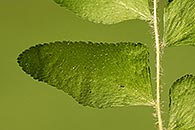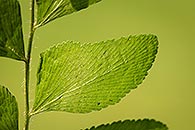Anemia dregeana Kunze
Synonyms |
|
|---|---|
Common name |
|
Description |
Rhizome erect to suberect, c. 10 mm in diameter. Fronds tufted, erect to arching, hemidimorphic, herbaceous to subcoriaceous. Stipe 4-20 cm long, straw-coloured, densely set with hair-like scales, 1-5 mm long, falling of with age, stipe of the fertile fronds 2-3 times longer than that of the sterile fronds. Lamina oblong-lanceolate in outline, up to 27 × 7 cm, pinnate, but the fertile frond bearing a pair of modified basal pinnae. Sterile pinnae lanceolate to rhombic in outline, apex blunt, base asymmetrically wedge-shaped, small scales sparsely present along veins and costae, becoming subglabrous with age, margins minutely toothed, shortly petiolate. Fertile pinnea up to 14 cm long, 3-pinnate, plume-like from the lamina base, terminal spike bearing clustered sporangia in two rows on the ultimate segments along the naked costules. |
Notes | This taxa has pinnate sterile pinnae. |
Derivation | dregeana: this plant was first collected by J.F.Drege (1794-1881), German botanist. |
Habitat | Under decidious scrub in low altitude river valleys, in dry rocky hillsides, fairly wet conditions on forest floors and along streams in full shade. |
Distribution worldwide | Endemic to southern Africa. |
Distribution in Africa |
|
Growth form |
Terrestrial. |
Literature |
|






